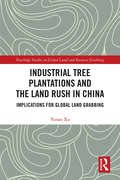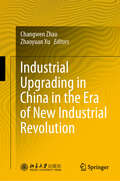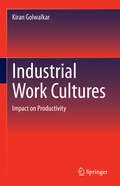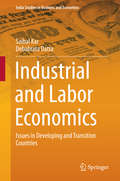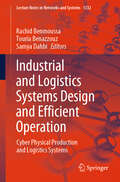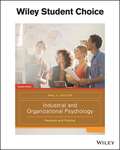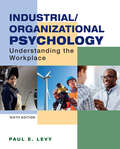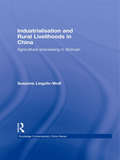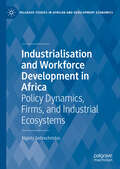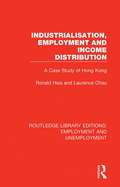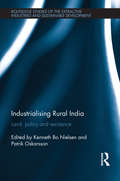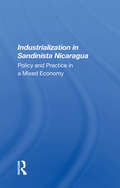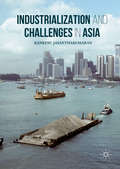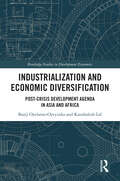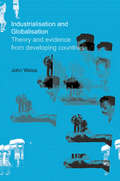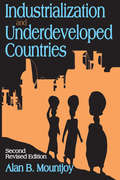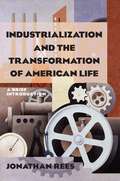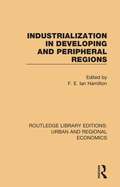- Table View
- List View
Industrial Tree Plantations and the Land Rush in China: Implications for Global Land Grabbing (Routledge Studies in Global Land and Resource Grabbing)
by Yunan XuThis book analyses the political and economic causes, mechanisms and impacts of the industrial tree plantation boom in China. In the past two decades, the industrial tree plantation sector has been expanding rapidly in China, especially in Guangxi Province. Based on extensive primary data, this book concentrates on the political economy of the sector’s expansion with a focus on the recent and dramatic agrarian transformation involving the land-labour nexus, the impact on villagers’ livelihoods, the role of the state, and political reactions from below. The book questions the stereotypical portrayal of local communities as the excluded villager. Instead, it demonstrates that this is a much more complex issue with varying levels of passive and active forms of inclusion and exclusion within local communities. While most literature focuses on crop booms for food and biofuel production the industrial plantation sector has largely been overlooked, despite it being one of the biggest sectors in the current rush for land. Filling this lacuna, this book also reveals that while China has traditionally been painted as a major land grabber and consumer of crop booms it is also a destination of foreign investment. In doing so the book highlights how large-scale foreign land deals can also take place in traditional ‘grabber’ countries like China which feeds into the wider debates about global land politics and resource grabbing. This book will be of great interest to students and scholars of land grabbing, rural development and agrarian transformations, as well as Chinese development.
Industrial Unemployment in Germany 1873-1913 (Routledge Library Editions: The German Economy #5)
by Linda A. HeilmanOriginally published in 1991 this book provides a multi-faceted analysis of German unemployment between 1873 and 1913. It can also be read as an example of social scientific historiography during the fourth quarter of the twentieth century. Finally, the study has value for the comparative perspective it lends to current economic, social, and political turmoil in Germany, Europe, and the United States. While the precise conditions in the USA differ today, there are clearly still lessons to be learned on both sides of the Atlantic from the economic, social, and political dislocation, which accompanied industrial unemployment in Germany between 1873 and 1913. .
Industrial Upgrading in China in the Era of New Industrial Revolution
by Changwen Zhao Zhaoyuan XuThis book delves into China's transition to mid-to-high-end industries amid a new wave of global industrial revolution. It explores the fundamental principles and current dynamics of industrial upgrading, addressing topics such as industrial policies, managing overcapacity, and the removal of inefficient enterprises, all viewed through historical experiences, objective analyses, and systemic considerations. Based on the in-depth analysis of China’s advantages, challenges and strategic choices, the book concludes that upgrading is a must way-to go for China, involving pivotal areas such as structural upgrading, value chain optimization, product space expanding, quality enhancing, platform economy and sharing economy developing, as well as the intersection of finance with industrial upgrading.
Industrial Work Cultures: Impact on Productivity
by Kiran GolwalkarThis book addresses technical issues and human factors mainly from the mechanical, chemical, electrical, metallurgical and civil engineering fields as these make significant contribution to the economy and progress of a nation. It discusses factors that assist development of efficient, ideal work cultures and their influence on the productivity. It addresses undesirable traits in the working personnel which can cause deviations from good working practices. Suggestions are given for encouraging better performance and corrective actions for improvement of unsatisfactory working.
Industrial and Labor Economics
by Saibal Kar Debabrata DattaThis book is an attempt to capture and analyze several idiosyncratic features of industry and labor in the developing world. Available books and graduate-level texts in labor economics largely discuss industrial and labor market situations prevalent in developed countries, where well-defined institutional arrangements and regulations create a very different scope of analysis. The patterns of choice in training and contracts in the labor market more apparent in developing and transition countries are discussed, as are the information-theoretic results. The book also critically examines labor migration, a context in which the developing and transition countries represent large sources in the present global order. A broad base of empirical observations from industries is used to develop analytical conjectures on risk-sharing arrangements between workers and employers, while strong intuitive explanations are combined with relevant mathematical and graphical derivations, ensuring the book's readability among graduate students pursuing courses in labor economics and industrial economics for developing and transition countries. The book may also serve as a valuable reference guide for all students in advanced human resources courses at management schools. Presenting state-of-the art research findings in all of its chapters, the book discusses numerous institutional peculiarities of the developing world, making the results distinct in view of the general scope of labor economics.
Industrial and Labour Market Policy and Performance: Issues and Perspectives (Routledge Studies in Business Organizations and Networks #Vol. 26)
by Dan Coffey Carole ThornleyIndustrial issues are often inextricably linked with labour market concerns and policy approaches that attempt to consider production and employment separately are inherently flawed."This controversial statement sums up the heart of this important book. With contributions from such scholars as Keith Cowling, Malcolm Sawyer and Michael Kitson, Industrial and Labour Market Policy and Performance covers such topics as:* the increasing inequality between rich and poor* the links between innovation, competition and collaboration* education, skills formation and human resource managementThe evidence-led nature of the book will make it an important and useful read for students and academics involved in labour economics, industrial economics and industrial policy. The controversial findings of many of the chapters and its readable style will also appeal to informed policy commentators as well as policy-makers themselves.
Industrial and Logistics Systems Design and Efficient Operation: Cyber Physical Production and Logistics Systems (Lecture Notes in Networks and Systems #1332)
by Rachid Benmoussa Touria Benazzouz Samya DahbiThis book aims to provide recent achievements in the efficient design and operation of industrial and logistics systems. To achieve excellence, digital transformation is currently an essential path for systems reengineering. This path is still in an exploratory phase for industrial and logistics systems, as they cover a wide range of sectors and are composed of several complementary views.Thus, this book reconciles classic methods with modern ones based on digital transformation and Industry 4.0 technologies, which aim to optimize, improve, restructure, and evaluate a broad scope of systems, focusing on their four complementary views: operational, informational, technological, and decisional.It is intended for researchers and postgraduates in industrial engineering and logistics, professionals in senior management positions in industrial and logistics companies, as well as undergraduates in industrial and logistics engineering programs.
Industrial and Organizational Psychology: Research and Practice
by Paul SpectorThe field of industrial and organizational psychology continues to see attention and growth and has become one of the major applied specialties in the study of psychology. Since findings from research in this field are relevant to everyone who has held a job, and the field has developed proven methods that businesses and organizations need, industrial and organizational psychology is an excellent demonstration of how society can benefit from the study of psychology. The 6th Edition of Industrial and Organizational Psychology incorporates all new and updated literature that has been written on the topic since the 5th edition. Spector's goal is to provide an overview and comprehensive understanding of organizational psychology. Each of the major areas that comprise industrial and organizational psychology is covered in five parts: introduction to the discipline; assessment of jobs, performance, and people; selecting and training employees; the individual and the organization; and the social context of work.
Industrial, Trade, and Employment Policies in Iran: Towards a New Agenda
by Pooya Alaedini Mohamad R. RazaviThis volume explores Iran’s industrial and trade policy options for achieving sustainable, export-oriented, and pro-employment growth. The first part of the book discusses Iran’s economic and industrial development performance, as well as strategies for enhancing capabilities, fostering productive transformation, and developing employment that can result in faster and more inclusive economic growth. It also presents a case study on a leading manufacturing subsector—the automotive industry. The book then offers a set of analyses concerning the country’s trade sector, including exchange rate policies, ways to connect to global markets, and accession to the World Trade Organization. In turn, the closing chapters investigate various aspects of Iran’s labor market and offer policy recommendations on the creation of productive jobs. Readers will learn about effective industrial, trade, and employment policies that can complement macroeconomic measures adopted by the government. As such, the book will appeal not only to scholars and policy-makers, but also to international investors seeking to understand various core aspects of Iran’s industrial and employment structures and trade regime.
Industrial/Organizational Psychology: An Applied Approach
by Michael G. AamodtStrike a balance between the latest research, proven theory and practical application as you demonstrate the relevance of industrial and organizational psychology to everyday life with Aamodt’s INDUSTRIAL/ORGANIZATIONAL PSYCHOLOGY: AN APPLIED APPROACH, 9E. <p><p>A wealth of updated applications work within an engaging narrative that guides students in analyzing topics such as interview survival, creating job descriptions, performance appraisal, changes in today's employment law, job satisfaction, work motivation and leadership. Students review timely topics such as gamifaction and the virtual workplace. Using a reader-friendly writing style, the author integrates humor, engaging and updated case studies and real examples from business today to make concepts both understandable and relevant for your students. The latest innovative charts, tables and flowcharts work with revised exercises prepare students to conceptualize complex issues.
Industrial/Organizational Psychology: An Applied Approach (Sixth Edition)
by Michael G. AamodtStriking a balance between research, theory, and application, the sixth edition of INDUSTRIAL/ORGANIZATIONAL PSYCHOLOGY: AN APPLIED APPROACH prepares readers for their future careers through a combination of scholarship, humor, case studies, and practical applications. Readers will see the relevance of industrial/organizational psychology their everyday lives through such practical applications as how to write a resume, survive an employment interview, write a job description, create a performance appraisal instrument, and motivate employees. Charts and tables simplify such complicated issues as employment law, job satisfaction, work motivation and leadership.
Industrial/Organizational Psychology: Understanding The Workplace
by Paul LevyWritten by a leading researcher in one of the nation’s top I/O programs, Paul Levy’s text has long been acclaimed for its concise, research-based approach and personable writing. With this thoroughly updated new edition, students have ample opportunities to explore what’s happening in I/O psychology today, through voices directly from the field (Practitioner Forum), brief takes on current events issues (I/O Today), applied practice (Taking it to the Field), and critical and applied exercises at the end of each chapter. Supplementary resources include a thorough Instructors Manual with additional practice activities as well as teaching tips, and a robust test bank.
Industrialisation and Rural Livelihoods in China: Agricultural Processing in Sichuan (Routledge Contemporary China Series)
by Susanne Lingohr-WolfSince the mid-1990s, "agricultural industrialisation" (AI) has been advocated in China to promote rural development by integrating agriculture with the post-harvest sectors such as agro-processing and marketing. Large-scale "Dragon head enterprises" (DHEs) and various forms of rural household associations (RAs) have been particularly promoted as AI organisational models. Drawing on the case study of the sweet potato sector in Sichuan Province, this book investigates their impact on rural livelihoods. Lingohr-Wolf analyses the forms of household linkages with AI organisations, the underlying household incentives to diversify both labour and agricultural production towards AI, and the developmental benefits and potential constraints that shape such rural involvement. By taking a rural household perspective on livelihood diversification, the analysis provides new insights into the links between rural household involvement in AI and the achievement of development objectives. It reveals that although there are significant beneficial effects, a number of challenges, such as entry barriers and imbalances in bargaining power, still need to be addressed to improve the positive impact of AI for rural development in China. As the first authoritative analysis of AI in China, this book is an essential read for scholars interested in economic development in China and rural development and agricultural economics more generally.
Industrialisation and Workforce Development in Africa: Policy Dynamics, Firms, and Industrial Ecosystems (Palgrave Studies in African and Development Economics)
by Nigisty GebrechristosThis book explores the dynamics and challenges of building an industrial workforce and industrialisation in Africa. It highlights the potential for economic growth within the manufacturing sector and how industrialisation can provide employment, build industrial workforce and facilitate labour market opportunities. Government policies and the role of local and regional governments are analysed to examine why certain industrial parks perform better than others. With particular details drawn from Ethiopia’s apparel and textile industry, the historical relationship between capitalist development and the labour force is explored to show tensions between maximising profits and ensuring labour rights and better wages. Building an industrial workforce necessitates effective government policies, firm strategies, industrial ecosystems, and productive dialogue and collective learning between government and firms.
Industrialisation and the British Colonial State: West Africa 1939-1951
by Lawrence ButlerTaking colonial policy towards West Africa as a case study, Butler shows that, during the 1940s, the Colonial Office evolved a policy of encouraging colonial industry as part of a broad programme of development intended to prepare colonies for independence.
Industrialisation, Employment and Income Distribution: A Case Study of Hong Kong (Routledge Library Editions: Employment and Unemployment #3)
by Ronald Hsia Laurence ChauFirst published in 1978. In spite of the wide recognition of Hong Kong’s successful growth record, little is known about the impact that rapid industrialisation has had on income distribution. The transformation of an entrepôt economy into an industrial one has been accompanied by a transition from a labour surplus to a labour shortage economy, which has had a profound influence on the distribution of income by size. The effect has been channelled through a number of variables such as the composition of employment by industry, occupational structure, labour force participation rate and wage structure. All these changes have, moreover, owed much to the existence of a market mechanism which has been virtually free from government intervention. Beginning with a comprehensive evaluation of the effects of the various characteristics of employment and the labour force on household income distribution, this study assesses the impact of Hong Kong’s industrialisation and employment growth on its income distribution. Through an analysis of the changes in industrial and occupational structures, employment status, household size, labour participation rate, inflow of labour and wage and employment structures, it considers not only how income distribution alters with economic development, but also the mechanism that has brought about these changes. The redistribution effect of government activities is examined and the incidence of particular taxes to different income groups is apportioned to give a clear overall picture. Finally, the benefits obtained from government expenditures on housing, education and health are measured and are allocated to different income groups, illustrating how this has appreciably reduced income inequality in Hong Kong.
Industrialising Rural India: Land, policy and resistance (Routledge Studies of the Extractive Industries and Sustainable Development)
by Kenneth Bo Nielsen Patrik OskarssonRapid industrialisation is promoted by many as the most feasible way of rejuvenating the Indian economy, and as a way of generating employment on a large scale. At the same time, the transfer of land from rural communities and indigenous groups for industrial parks, mining, or Special Economic Zones has emerged as perhaps the most explosive issue in India over the past decade. Industrialising Rural India sheds light on crucial political and social dynamics that unfold today as India seeks to accelerate industrial growth. The volume examines key aspects that are implicated in current processes of industrialisation in rural India, including the evolution of industrial and related policies; the contested role of land transfers, dispossession, and the destruction of the natural resource base more generally; and the popular resistance against industrial projects, extractive industries and Special Economic Zones. Combining the work of scholars long established in their respective fields with the refreshing approach of younger scholars, Industrialising Rural India seeks to chart new ways in the study of contemporary industrialisation and its associated challenges in India. This cutting-edge interdisciplinary work will be of interest to scholars working on industrial development and land questions in India and South Asia alongside those with an interest in sociology , political science and development research.
Industrialization In Sandinista Nicaragua: Policy And Practice In A Mixed Economy
by Andrew ZimbalistThis book explores whether the Sandinista 'mixed economy'—a 'transitional' mixed economy—could have been stable if the Sandinistas had been able to pursue their industrialization strategy for a longer period of time. It explains why Nicaragua's mixed economy was stable for almost eleven years.
Industrialization and Challenges in Asia
by Kankesu JayanthakumaranThis book provides a much-needed review of Asia's economic growth and its challenges in the context of post-war industrialization. In the early 1990s, the World Bank (1993) recognized eight high-performing Asian economies (HPAEs) (Japan, the Asian tigers, Indonesia, Malaysia and Thailand) and named them the 'Asian economic miracle'. In the recent past, the term 'emerging economies' has been widely used to refer to the high-growth economies, and includes China, India, Mongolia and Vietnam. In this rush towards high growth, the adverse effects of industrialization are widespread, but were unnoticed. The major challenge is to bring together a comprehensive picture of Asia's growth, taking into account the adverse consequences. Finally, this book examines two challenges for the future of Asia's development: the global financial crisis and urban poverty and inequality.
Industrialization and Economic Diversification: Post-Crisis Development Agenda in Asia and Africa (Routledge Studies in Development Economics)
by Banji Oyelaran-Oyeyinka Kaushalesh LalEconomic diversification entails a shift away from a single income source toward multiple income sources from an increasing spectrum of sectors and markets. A persistent concern for some Asian and African economies is their reliance on commodity exports and how they are exposed to the risk of export volatility and income instability. The Covid-19 pandemic and previous oil crashes have demonstrated the adverse impact on such economies. This book provides a systemic analysis of sustainable economic development through economic diversification. The book analyzes diversification and development experiences from comparative perspectives of Asia and Africa. It also investigates determinants of export diversification differentiated by commodities-dependence versus manufactured products and looks at the roles of various institutions and governance of institutions in export diversification. This book will provide policy insights into how different degrees of specialisation in exports across countries have affected outcomes in terms of living standards, economic growth and employment.
Industrialization and Globalization: Theory and Evidence from Developing Countries
by John WeissIn a refreshingly accessible style John Weiss presents a survey of industrialization in developing countries since 1945, as well as a study of the predominant theories of industrial growth in the Third World. This authoritative text analyzes:* the possibility of different paths to industrialization* the dominant neoclassical view and the challenges
Industrialization and Underdeveloped Countries
by Alan B. MountjoyThe volume of relevant research and literature on this topic is growing but originates mainly from economists, sociologists, and political scientists; geographers have been slow to make contributions. One reason may be that geographers have been preoccupied with differentiation within the geography of production whereas this new field directs attention to the geography of consumption and a study of economies. This book aims to focus attention on the complex and inter-related problems--social, economic, political, and geographical--that come with development, placing particular emphasis on the problems which accompany attempts at industrialization. Focusing on the complex and interrelated social, economic, political, and geographic problems that attend under-development, this book presents one of the first contributions from a geographer on what has been called the most important economic problem of the modern world.Contending that industrialization is no answer for under-developed countries that are striving to maintain expanding populations and to strengthen their economy, Alan B. Mountjoy traces the distribution, causes, and problems of under-development and the difficulties with and possibilities for industrialization as an aid in solving those problems. He defines development and under-development, considers problems of industrialization (including environmental and human problems), discusses the forms industrialization takes, and analyzes the progress of industrialization in specific under-developed areas.The unique geographer's perspective and the ability of the author to select aspects of the study that most clearly reflect the problems of under-developed economies make this work a useful text and reference book for students and scholars of development, economic geography, and international relations.
Industrialization and the Transformation of American Life: A Brief Introduction
by Jonathan ReesThis book provides a descriptive, episodic yet analytical synthesis of industrialization in America. It integrates analysis of the profound economic and social changes taking place during the period between 1877 and the start of the Great Depression. The text is supported by 30 case studies to illustrate the underlying principles of industrialization that cumulatively convey a comprehensive understanding of the era.
Industrialization in Developing and Peripheral Regions (Routledge Library Editions: Urban and Regional Economics)
by F.E. Ian HamiltonThe ten years before this book was originally published in 1986 saw major restructuring in the economies of the developed world. This was often closely related to industrial development in newly industrializing and third world countries. This book examines the performance of these developing countries and includes studies of 'peripheral regions' – less developed regions within more advanced economies. The overall findings are that whilst some areas and countries have success stories to tell (such as Korea), many so-called newly industrializing countries and regions have had serious problems.
Industrialization in Malaysia: Import Substitution and Infant Industry Performance (Routledge Studies in the Growth Economies of Asia #Vol. 7)
by Rokiah AlaviSome of the most successful growth economies in the Pacific Rim have combined protectionist Import Substitution Industrialisation policies with export-oriented policies. This study provides a systematic rethinking of relationships between strategies within the Malaysian context.
